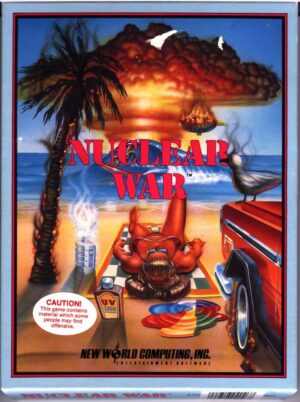Retro Replay Review
Gameplay
Rick Dangerous delivers a classic, trial-and-error style platforming experience that immediately hooks players with its relentless pacing and cleverly hidden threats. Each of the over 100 screens is carefully designed to test your reflexes and your patience, with deadly pitfalls, surprise enemies, and devious traps lurking around every corner. You’ll often find yourself sticky-footed on breakaway floor panels or blasted by dart traps if you don’t move with caution—or memorization.
(HEY YOU!! We hope you enjoy! We try not to run ads. So basically, this is a very expensive hobby running this site. Please consider joining us for updates, forums, and more. Network w/ us to make some cash or friends while retro gaming, and you can win some free retro games for posting. Okay, carry on 👍)
The dual-weapon system is deceptively simple but surprisingly deep. Rick carries a revolver for straightforward combat and a limited supply of dynamite sticks for those enemies he can’t shoot on the same horizontal plane. Judicious use of dynamite becomes a core strategic element; you’ll need to plan ahead when ammo is scarce or when standard shots simply won’t reach. In later levels, properly timing an explosion can be the difference between advancing and starting from scratch.
While the controls feel crisp and responsive for their era, the game’s real challenge comes from learning screen layouts and internalizing trap patterns. You’ll die countless times, but each failure reveals a bit more about how to navigate the next attempt. This methodical-learning loop may feel punishing to casual gamers, but it’s immensely rewarding for those who enjoy mastering every nuance of level design.
Progression is constant, with distinct regions—from dense jungles to winding Egyptian tombs to a perilous Nazi stronghold—each introducing new hazards and enemy types. The exotic settings keep the action fresh and compel you to uncover every secret path. By the time you reach the final screens, you’ve developed an almost intuitive awareness of Rick’s movement physics, which turns seemingly impossible obstacles into beatable puzzles.
Graphics
Visually, Rick Dangerous captures the feel of late-’80s home-computer platformers with its crisp pixel art and bold color palette. Sprites are relatively small but well-defined, allowing you to distinguish traps, power-ups, and enemies even in busy sequences. The jungle levels burst with lush greens and browns, while the Egyptian screens use sandy yellows and muted reds to evoke tunnel passages and ancient chambers.
Animation is smooth for the time, with Rick’s springy run cycle and leap taking on a cartoonish charm. Enemies move in predictable patterns, which helps once you’ve scouted a screen’s danger zones, but their simple motions belie the severity of their threat. When a mummified foe or a Goering-esque soldier lunges at you, the pixel-perfect collision detection leaves no room for sloppy jumps.
The backgrounds—though static—are detailed enough to convey a sense of place without distracting from the foreground action. Hieroglyph-patterned walls, flickering torches, and Nazi insignia all add atmosphere. While modern gamers may find the visuals rudimentary compared to today’s standards, Rick Dangerous retains a nostalgic appeal that’s both functional and evocative.
Story
Rick Dangerous doesn’t dazzle with a deep or original narrative, but it leans into its Indiana Jones–inspired premise with confidence. You’re on the trail of the lost Coolu Amazon tribe, only to have your plane shot down by hostile warriors. From the moment you crash land, the plot serves primarily as a reason to keep forward momentum—and that’s just fine for a game built on action and exploration.
Each stage’s backdrop hints at a larger adventure: escaping the jungle, infiltrating a pyramid, and finally storming a clandestine Nazi base. Though dialogue is all but non-existent, little touches—like scattered tribal artifacts or swastika-emblazoned crates—reinforce the stakes. It’s a straightforward pulp-adventure setup, but one that keeps your interest high as you push through each obstacle.
The sparse story beats are bolstered by evocative level design rather than cutscenes or text dumps. You piece together Rick’s saga through visual cues: the wrecked plane’s fuselage, underground tomb paintings, and the final showdown’s heavy guard presence. While not a narrative masterpiece, the sparse storytelling focuses attention squarely on the perilous journey itself.
Overall Experience
Rick Dangerous offers a demanding yet fair challenge that feels tailor-made for players who relish punishing platformers and meticulously crafted level puzzles. Its difficulty curve is steep, but each newfound shortcut or trap avoidance strategy yields a genuine sense of accomplishment. Expect to die often—then learn, adapt, and conquer.
The game’s bite-sized screens make it easy to pick up for quick bursts of play, yet complete mastery demands a longer-term commitment. Replay value is high, as discovering hidden passages and perfecting no-death runs can keep you returning long after your first victory. For retro-gaming enthusiasts, Rick Dangerous stands as a shining example of smart, skill-based design.
Controls remain tight, and the balance between gunplay and dynamite usage ensures encounters never feel repetitive. Paired with the evocative pixel environments and a world that effortlessly channels pulp-adventure tropes, the overall experience is both nostalgic and timelessly engaging. If you’re in the market for a classic platformer that rewards patience, memorization, and tenacity, Rick Dangerous is a treasure worth hunting.
 Retro Replay Retro Replay gaming reviews, news, emulation, geek stuff and more!
Retro Replay Retro Replay gaming reviews, news, emulation, geek stuff and more!









Reviews
There are no reviews yet.